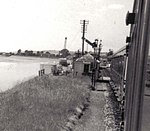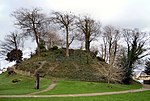Barnstaple railway station
1854 establishments in EnglandBuildings and structures in BarnstapleDfT Category E stationsFormer London and South Western Railway stationsIndustrial archaeological sites in Devon ... and 6 more
Pages with no open date in Infobox stationRailway stations in DevonRailway stations in Great Britain opened in 1854Railway stations on the South West Coast PathRailway stations served by Great Western RailwayUse British English from April 2017

Barnstaple railway station is the northern terminus of the Tarka Line and serves the town of Barnstaple, Devon. It is 39 miles 75 chains (64.3 km) from Exeter Central and 211.25 miles (339.97 km) from London Waterloo. It is managed by Great Western Railway, which also operates the passenger service. It opened in 1854 but, from 1874 until 1970, it was known as Barnstaple Junction railway station, as it was the junction between lines to Ilfracombe, Bideford, Taunton and Exeter.
Excerpt from the Wikipedia article Barnstaple railway station (License: CC BY-SA 3.0, Authors, Images).Barnstaple railway station
Station Road, North Devon Sticklepath
Geographical coordinates (GPS) Address Nearby Places Show on map
Geographical coordinates (GPS)
| Latitude | Longitude |
|---|---|
| N 51.074 ° | E -4.063 ° |
Address
Station Road
EX31 2AU North Devon, Sticklepath
England, United Kingdom
Open on Google Maps










